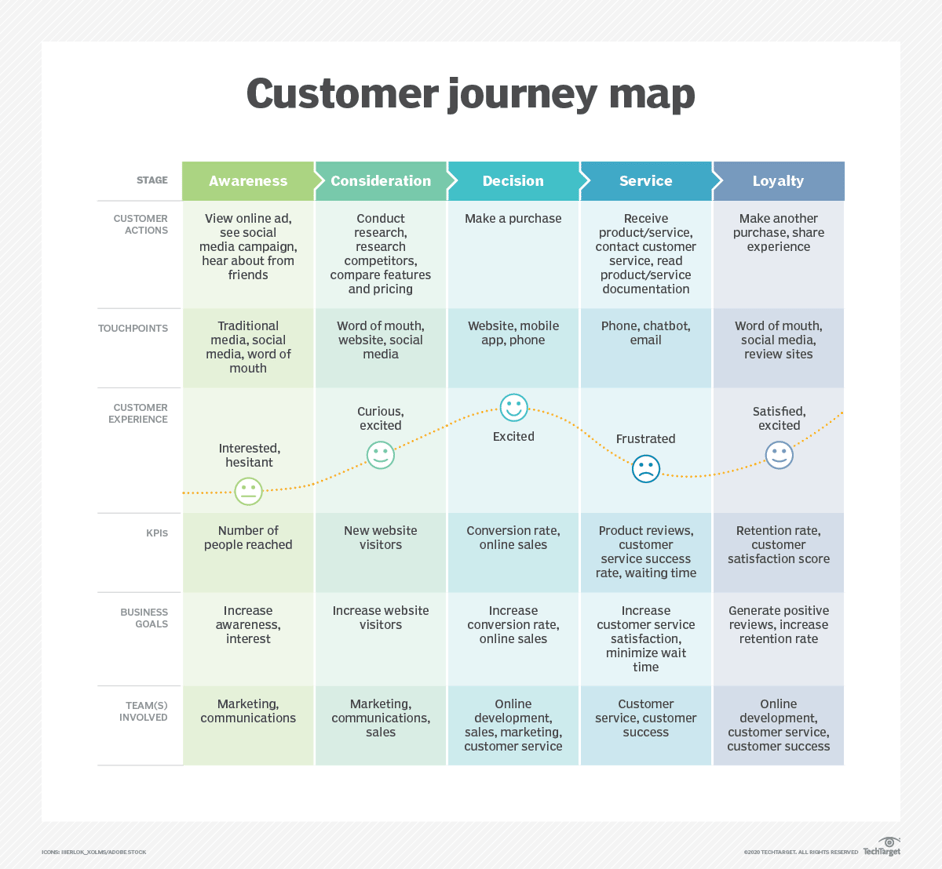If you’re a business owner or manager, then you likely already know why great customer service is imperative to the success of your business.
It’s simple math: Poor customer service equals poor retention. And poor customer retention equals poor profits.
Recent stats show that businesses in the U.S. lose $62 billion dollars each year due to poor customer service.
I know what you’re thinking “…but my customer service is already great!” That may be true, but the consequences of being wrong are too severe. Word of mouth spreads across social media like wildfire. Tales of bad customer service run rampant. Failing to meet customer expectations can quickly lead to negative reviews and lost business.
So we’re left with the burning question, “What can I do to improve my customer service if it’s already great?”
Enter the power of customer journey mapping.
It helps your team to better understand and address customer needs and pain points as they experience your product or service. Identifying customer pain points is a key focus of journey mapping, allowing you to proactively resolve issues and enhance the overall customer experience.
What exactly is customer journey mapping?
A customer journey map is a powerful visualization and storytelling tool. As a visual tool, it allows teams to clearly see and analyze the customer's experience throughout their interactions with your brand. It helps your team to better understand and address customer needs and pain points as they experience your product or service. Mapping out the touchpoints of a customer’s journey helps you to see potential pain points from an unbiased perspective. This process enables you to gain a more holistic understanding of the customer's experience across all stages of their journey.
Customer journey mapping is a common practice in the UX/UI field. It’s also gained traction in recent years with other product and service verticals. Business owners and managers alike are coming to realize that data alone fails to communicate the pain points and experiences of customers. A story can do that, and one of the best storytelling tools in business is the customer journey map.
While it’s important to note that a customer service journey map by itself won’t ensure the outcomes you’re looking to create, it can be incredibly useful as a tool to better understand what it’s really like on the customer’s side of the experience. By adopting the customer's perspective and putting yourself in your customer's shoes, you can gain deeper insights into their needs and challenges. (We dive a bit deeper on the strengths and limitations of the customer journey map here.)
Benefits of creating a customer journey map
Creating a customer journey map is more than just a visual exercise—it’s a strategic move that can transform your business. By mapping out the customer journey, you gain a deeper understanding of how customers interact with your brand at every stage. This comprehensive view helps you pinpoint pain points and friction, leading to targeted improvements that boost customer satisfaction and loyalty.
A well-crafted customer journey map helps you see your business through your customers’ eyes, revealing opportunities to enhance their experience and exceed their expectations. As a result, you’ll see increased conversion rates, stronger customer retention, and a more seamless customer journey overall. Journey mapping also encourages cross functional collaboration, bringing together teams from across your organization to align on a shared vision for creating a customer journey that delights at every touchpoint.
Ultimately, customer journey mapping empowers you to make data-driven decisions, prioritize initiatives that matter most to your customers, and drive sustainable growth. When everyone is working from the same journey map, your entire organization is better equipped to deliver exceptional customer experiences.
What does a great customer journey map look like?
The following image depicts a basic customer journey map. Note the typical emotions of the customers as they go throughout each stage of their journey: Tracking the customer's emotional journey and understanding customers emotions at each stage is crucial for tailoring content and improving the overall customer experience.

Image via TechTarget
While that template illustrates an average customer journey, it’s important to note that every company should have a slightly different one – and even the best customer journey map won’t necessarily reflect the actual customer experience as it is (but more on that later). Each stage highlights key customer touchpoints, which are critical moments where brands can engage and influence customers throughout their journey. Journey maps can also be used to anticipate and plan for future interactions with customers, supporting long-term engagement and business growth.
Types of customer journey maps
Not all customer journey maps are created equal—different types serve different purposes, depending on what you want to achieve. Here are the most common types of customer journey maps you might use:
-
Current State Map: This journey map captures the customer’s experience as it is today, highlighting pain points and areas where the journey could be smoother. It’s a great starting point for identifying what needs fixing right now.
-
Future State Map: Looking to the future? This map visualizes the ideal customer journey you want to create. It helps you set goals and outline the improvements needed to reach that future state.
-
Day-in-the-Life Map: This type of customer journey map goes beyond your product or service, showing a detailed, chronological view of a customer’s daily interactions with your brand. It’s perfect for understanding the broader context of your customer’s experience.
-
Service Blueprint: A service blueprint takes journey mapping a step further by mapping out the behind-the-scenes processes, people, and systems that support the customer experience. It’s invaluable for service design and ensuring your internal operations align with customer needs.
-
Emotional Journey Map: Sometimes, the most important insights come from understanding how your customers feel. An emotional journey map tracks the customer’s emotional highs and lows throughout their journey, helping you address pain points and create more positive experiences.
By choosing the right type of journey map for your goals, you can gain actionable insights and drive meaningful improvements in your customer experience.
Creating a customer journey map
Customer journey maps can (and should) take a wide variety of forms. The end goal, however, is always the same: find and resolve the pain points of your customers … a.k.a friction. It’s important to identify each specific pain point in the journey to ensure no issues are overlooked. Mapping customers actions and customer interactions throughout the process helps you understand how customers engage with your brand and where improvements can be made. So, what’s the first step to creating a great journey map?
1. Define your persona (lens)
All customers are different, but it’s important to create a few personas that help you to understand their unique perspectives. A buyer persona and customer persona are detailed representations of your target customers, and play a crucial role in journey mapping by helping you identify customer behaviors, preferences, and objectives. For example, in the customer journey mapping of a grocery store purchase, a mother of five young kids will have a much different lens than a single male in his 30s. Creating multiple buyer personas allows you to tailor the journey map to different customer segments and improve your marketing strategies.
2. Identify the timeline of your customer journey
Once you’ve defined your persona, you have to identify the length of the buyer’s journey. The buying journey consists of several phases, such as awareness, consideration, and decision, that customers move through before making a purchase. How long does it take to start at consideration all the way through purchasing your product? This is done in a finite amount of time (e.g., 1 week or 1 year) or variable phases (e.g., awareness, consideration, decision). Analyzing purchase history can provide valuable insights into the timeline and touchpoints of the buying journey.
3. Plot the touch points
Next, identify what and where the customer actions and interactions are occurring. Consider the people involved in these interactions, such as sales reps, customer service reps, and service teams, as they play a crucial role in shaping the customer experience. Whether they’re paying a bill online or picking up a cake, identifying these touch points and use these as your horizontal axis. At each of these customer touchpoints, also take note of the physical evidence present—such as receipts, menus, or the environment—which can influence customer perceptions and support service delivery.
This is also a good time to understand how your customers might reach out to you. Will it be over the phone? Using chat? Through social media? Mapping all customer touchpoints across different platforms ensures you capture every interaction. Knowing the channels your customers use most lets you better understand where to put your customer service resources.
4. Plot the emotions, actions, and questions
Now you’ve reached what is arguably the most critical step in customer journey mapping. It’s essential to plot out the emotions, actions, and questions that a customer experiences during each touchpoint. By doing this, you gain a comprehensive understanding of the customer's journey as a whole, from initial contact to post-purchase interactions. At each stage, it is important to identify customer pain to address specific issues or frustrations that may arise and improve the overall experience. Brainstorm and reflect on past experiences to uncover responses point through the lens of each persona.
5. Determine points of friction
Every business will look through the lens of their customer personas differently. Walking through each of these columns with your team will help you to identify any points of friction within the customer experience. Reviewing your support processes, business processes, and organization supports can help pinpoint sources of friction that may not be immediately visible. Implementing or updating standard operating procedures can address and prevent these friction points, ensuring a smoother customer journey.
Of course, every business is different and YOU will know your customers best. Below are a few example questions to get you started:
-
Where could friction appear in this particular touchpoint?
-
Are people abandoning purchases because of this?
-
Are customers not aware of this solution that we’ve already provided? If so, why not?
To better understand where friction occurs, teams should conduct research and research solutions that customers are seeking, using structured methods to gather insights.
Also, while it’s always worthwhile to identify potential points of friction with a customer journey map, it will always be more impactful if you have a way for customers to reach out for support, no matter where they are in their journey. Analyzing unsolicited data, such as website behavior and support interactions, can also uncover hidden friction points that might otherwise go unnoticed.
This is precisely where Glance Guided CX solutions can provide a one-button avenue for people to connect with members of your team, demonstrate exactly where they’re having trouble, and receive hands-on support from someone they can see and speak to.
6. Resolve where you can
Once you’ve had a chance to identify the points of friction that customers experience, it’s time to step back and start thinking of solutions. This is where you’ll find it most helpful to get input from your team, as they’ll have perspectives from all sides of the business. Using service blueprints can help resolve behind-the-scenes issues by mapping both front-stage and back-stage activities that support the customer journey. Understanding why customer journey mapping important is crucial, as it provides insights into customer behaviors and pain points, driving meaningful improvements in customer experience.
You should also think about what medium you will use to solve problems. Is it about better training so customer support can answer complex questions? Having the rightvisual engagement tools on your website to quickly see and solve online issues? Making sure there are enough customer service employees to handle requests? While metrics like website traffic are useful, they should not overshadow the primary focus on enhancing customer experience.
Tools for customer journey mapping
You don’t need fancy software to get started with customer journey mapping, but the right tools can make the process smoother and more collaborative. Here are some popular options for creating customer journey maps:
-
Whiteboards and Sticky Notes: Sometimes, the simplest tools are the most effective. Gather your team around a whiteboard and use sticky notes to map out each step of the customer journey. It’s a hands-on, collaborative way to visualize the process.
-
Digital Tools like Mural, Lucidchart, or SmartDraw: These platforms offer user-friendly templates and features for building, editing, and sharing journey maps online. They’re great for remote teams or when you want a more polished visual representation.
-
Customer Journey Mapping Software (e.g., ServiceNow, Qualtrics): For more advanced needs, dedicated software can help you integrate customer data, analyze trends, and track changes over time. These tools are ideal for organizations looking to scale their journey mapping efforts.
-
Spreadsheets (Google Sheets, Microsoft Excel): If you prefer a data-driven approach, spreadsheets can help you organize customer actions, touchpoints, and pain points in a structured format.
-
Online Templates and Worksheets: There are plenty of downloadable templates and worksheets available to guide you through the journey mapping process, making it easy to get started even if you’re new to journey mapping.
No matter which tools you choose, the key is to create a customer journey map that accurately reflects your customers’ experiences and helps your team identify areas for improvement.
Measuring success with customer journey maps
Once you’ve invested time and effort into customer journey mapping, it’s important to track your progress and measure the impact. Here are some key metrics to help you gauge the success of your journey mapping initiatives:
-
Customer Satisfaction (CSAT) Scores: Regularly survey customers to see if their satisfaction improves as you address pain points identified in your journey map.
-
Net Promoter Score (NPS): Monitor changes in customer loyalty and advocacy. A rising NPS often signals that your customer experience is moving in the right direction.
-
Conversion Rates: Track how journey mapping influences sales, sign-ups, or other key actions. Improved conversion rates can be a direct result of a smoother customer journey.
-
Customer Retention Rates: Analyze whether customers are sticking around longer after you’ve made improvements based on your journey map. Higher retention means your efforts are paying off.
-
Return on Investment (ROI): Calculate the financial benefits of your journey mapping projects compared to the resources invested. This helps you demonstrate the value of journey mapping to stakeholders.
By keeping an eye on these metrics, you can ensure your customer journey mapping efforts are driving real, measurable improvements in customer satisfaction and business performance.
Common mistakes in customer journey mapping
Even the best intentions can go awry if you’re not careful. Here are some common mistakes to watch out for when creating customer journey maps—and how to avoid them:
-
Focusing Too Much on Internal Processes: It’s easy to get caught up in how your business operates, but remember, the customer journey map should reflect the customer’s perspective, not just your internal processes.
-
Not Involving Cross-Functional Teams: Journey mapping is most effective when it brings together voices from across your organization. Don’t make the mistake of working in a silo—collaborate with sales, support, marketing, and other teams to get a complete picture.
-
Relying on Assumptions Rather Than Data: Don’t guess what your customers are experiencing. Use customer feedback, survey customers, and analyze customer data to inform your journey maps and ensure they accurately reflect reality.
-
Not Regularly Updating the Map: Customer journeys evolve as your business and market change. Make it a habit to revisit and update your journey maps so they stay relevant and useful.
-
Not Using the Map to Drive Action: A customer journey map is only valuable if it leads to real improvements. Don’t let your map gather dust—use the insights to make changes that enhance the customer experience and address pain points.
By steering clear of these pitfalls, you’ll ensure your customer journey mapping efforts lead to meaningful, lasting improvements in your customer experience.
Final thoughts
The next time you have an upset customer, think about how journey mapping could help to proactively resolve that kind of situation.
Now that you've taken the time to learn about how to master your customer journey map, it's time to create a few for your own business. If you're interested in learning more about the process, we've listed a few helpful resources below:
And to get a real sense of how Glance Guided CX solutions lets your customers reach out to your support team precisely where and when they need help – feel free to reach out for a quick demo here!



